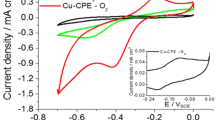Abstract
Electrocatalytic reduction of hydrogen peroxide at Prussian blue modified electrode has been studied with rotating disk electrode in pH 5.5 and 7.3 solutions. It has been shown that the electrocatalytic cathodic reduction obeys Koutecky–Levich relationship at electrode potentials ranging from 0.1 to −0.4 V vs. Ag/AgCl for low concentrations of peroxide not exceeding 0.3 mM. Within this potential window, the calculated kinetic cathodic current ranges within the limits of 2.15–6.09 and 1.00–3.60 mA cm−2 mM−1 for pH 5.5 and 7.3, respectively. For pH 5.5 and 7.3 solutions, a linear slope of the dependence of kinetic current on electrode potential of −10.8 and −2.89 mA cm−2 mM−1 V−1, respectively, has been obtained. At a higher concentration of peroxide, exceeding 0.6 mM, deviations from Koutecky–Levich relationship have been observed. These deviations appear more expressed at higher potentials and higher solution pH. The results obtained have been interpreted within the frame of two-step reaction mechanism, including (1) dissociative adsorption of hydrogen peroxide with the formation of OH radicals and (2) one-electron reduction of these radicals to OH− anions. At a higher concentration of peroxide, and especially at a higher pH, the second process becomes rate limiting.






Similar content being viewed by others
References
Neff VD (1978) J Electrochem Soc 125:886. doi:10.1149/1.2131575
Ellis D, Eckhoff M, Neff VD (1981) J Phys Chem 85:1225. doi:10.1021/j150609a026
Rajan KP, Neff VD (1982) J Phys Chem 86:4361. doi:10.1021/j100219a017
Itaya K, Akahoshi H, Toshima S (1982) J Electrochem Soc 129:1498. doi:10.1149/1.2124191
Itaya K, Ataka T, Toshima S (1982) J Am Chem Soc 104:4767. doi:10.1021/ja00382a006
Zukauskaite N, Malinauskas A, Dobrovolskis P (1985) Lietuvos TSR MA Darbai B Serija 2(147):8
Itaya K, Uchida I, Neff VD (1986) Acc Chem Res 19:162. doi:10.1021/ar00126a001
Itaya K, Shoji N, Uchida I (1984) J Am Chem Soc 106:3423. doi:10.1021/ja00324a007
Karyakin AA, Gitelmacher OV, Karyakina EE (1994) Anal Lett 27:2861
Karyakin AA, Gitelmacher OV, Karyakina EE (1994) Anal Chem 67:2419. doi:10.1021/ac00110a016
Karyakin AA (2001) Electroanalysis 13:813. doi:10.1002/1521-4109(200106) 13:10<813::AID-ELAN813>3.0.CO;2-Z
Karyakin AA, Karyakina EE (2001) Russ Chem Bull 50:1811. doi:10.1023/A:1014373811238
Ricci F, Palleschi G (2005) Biosens Bioelectron 21:389. doi:10.1016/j.bios.2004.12.001
Scholz F, Kahlert H (2006) In: Scholz F, Pickett CJ (eds) Encyclopedia of electrochemistry, vol 7. Wiley, Weinheim
Pandey PC, Singh B (2008) Biosens Bioelectron 24:842. doi:10.1016/j.bios.2008.07.016
Shan YP, Yang GC, Gong JA, Zhang XL, Zhu LD, Qu LY (2008) Electrochim Acta 53:7751. doi:10.1016/j.electacta.2008.05.035
Jia FL, Yu CF, Gong JM, Zhang LZ (2008) J Solid State Electrochem 12:1567. doi:10.1007/s10008-008-0521-7
Adhoum N, Monser L (2008) Sens Actuat B 138:588. doi:10.1016/j.snb.2008.03.039
Malinauskas A, Araminaitė R, Mickevičiūtė R, Garjonytė R (2004) Mater Sci Eng C 24:513. doi:10.1016/j.msec.2004.01.002
Araminaitė R, Garjonytė R, Malinauskas A (2008) Cent Eur J Chem 6:175. doi:10.2478/s11532-008-0021-8
Malinauskas A, Mickevičiūtė G, Araminaitė R, Garjonytė R (2006) Chem Anal Warsz 51:809
Karyakin AA, Karyakina EE, Gorton L (1999) Electrochem Commun 1:78. doi:10.1016/S1388-2481(99) 00010-7
Bard AJ, Faulkner LR (2001) Electrochemical methods. Fundamentals and applications, 2nd edn. Wiley, New York, pp 331–367
Damjanovic A (1969) In: Bockris JOM, Conway BE (eds) Modern aspects of electrochemistry, vol. 4. Plenum, New York
Acknowledgment
Financial support of this work by the Lithuanian State Science and Studies Foundation (project No. N07-009) is gratefully acknowledged.
Author information
Authors and Affiliations
Corresponding author
Rights and permissions
About this article
Cite this article
Araminaitė, R., Garjonytė, R. & Malinauskas, A. Electrocatalytic reduction of hydrogen peroxide at Prussian blue modified electrodes: a RDE study. J Solid State Electrochem 14, 149–155 (2010). https://doi.org/10.1007/s10008-009-0802-9
Received:
Revised:
Accepted:
Published:
Issue Date:
DOI: https://doi.org/10.1007/s10008-009-0802-9



